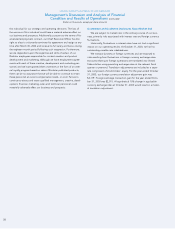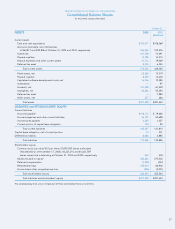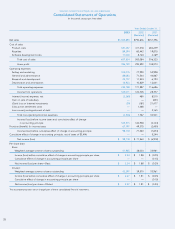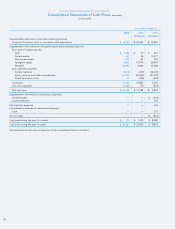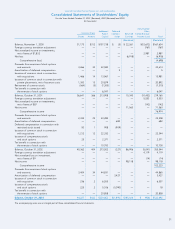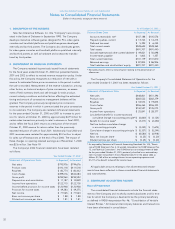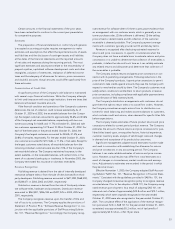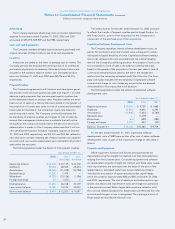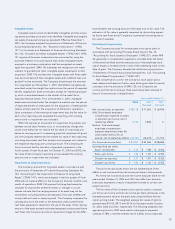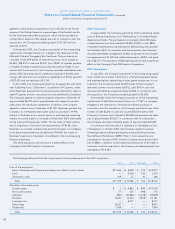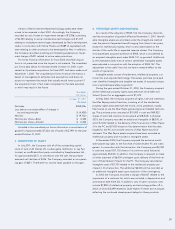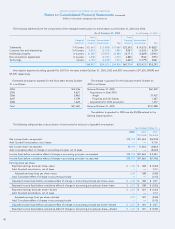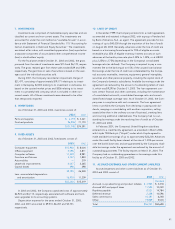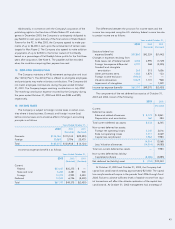2K Sports 2003 Annual Report Download - page 37
Download and view the complete annual report
Please find page 37 of the 2003 2K Sports annual report below. You can navigate through the pages in the report by either clicking on the pages listed below, or by using the keyword search tool below to find specific information within the annual report.
Intangible Assets
Intangible assets consist of identifiable intangibles and the remain-
ing excess purchase price paid over identified intangible and tangible
net assets of acquired companies (goodwill). Effective November 1,
2001, the Company adopted the provisions of Statement of Financial
Accounting Standards No. 141, “Business Combinations” (“SFAS
141”) in its entirety and Statement of Financial Accounting Standards
No. 142, “Goodwill and Other Intangible Assets” (“SFAS 142”). SFAS
141 requires all business combinations be accounted for using the
purchase method of accounting and that certain intangible assets
acquired in a business combination shall be recognized as assets
apart from goodwill. SFAS 142 addresses the recognition and meas-
urement of goodwill and other intangible assets subsequent to their
acquisition. SFAS 142 provides that intangible assets with finite useful
lives be amortized and that intangible assets with indefinite lives and
goodwill not be amortized. The Company discontinued the amortiza-
tion of goodwill as of November 1, 2001. Identifiable intangibles are
amortized under the straight-line method over the period of expected
benefit ranging from three to ten years, except for intellectual proper-
ty, which is amortized based on the shorter of the useful life or
expected revenue stream. Prior to November 1, 2001, intangible
assets were amortized under the straight-line method over the period
of expected benefit of seven years for the acquisition of development
studios and ten years for the acquisition of distribution operations.
Upon completion of the transitional impairment test, the fair value for
each of our reporting units exceeded the reporting unit’s carrying
amount and no impairment was indicated.
SFAS 142 requires an annual test for impairment of goodwill, and
between annual tests if events occur or circumstances change that
would more likely than not reduce the fair value of a reporting unit
below its carrying amount. In assessing potential impairment of good-
will, the Company determines the implied fair value of each reporting
unit using discounted cash flow analysis and compares such values to
the respective reporting unit’s carrying amount. The Company per-
forms its annual test for indication of goodwill impairment in the
fourth quarter of each fiscal year. At October 31, 2003 and 2002, the
fair value of the Company’s reporting units exceeded the carrying
amounts and no impairment was indicated.
Impairment of Long-Lived Assets
The Company accounts for long-lived assets in accordance with
the provisions of Statement of Financial Accounting Standards No.
144, “Accounting for the Impairment or Disposal of Long-Lived
Assets” (“SFAS 144”), which was adopted in the first quarter of fiscal
2003 with no material effect on the Company’s financial condition and
results of operations. SFAS 144 requires that long-lived assets be
reviewed for impairment whenever events or changes in circum-
stances indicate that the carrying amount of an asset may not be
recoverable, including assets to be disposed of by sale, whether pre-
viously held and used or newly acquired. The Company compares the
carrying amount of the asset to the estimated undiscounted future
cash flows expected to result from the use of the asset. If the carrying
amount of the asset exceeds estimated expected undiscounted future
cash flows, the Company records an impairment charge for the differ-
ence between the carrying amount of the asset and its fair value. The
estimation of fair value is generally measured by discounting expect-
ed future cash flows at the Company’s incremental borrowing rate or
fair value if available.
Stock-Based Compensation
The Company accounts for its employee stock option plans in
accordance with Accounting Principles Board Opinion No. 25,
“Accounting for Stock Issued to Employees” (“APB 25”). Under APB
25, generally no compensation expense is recorded when the terms
of the award are fixed and the exercise price of the employee stock
option equals or exceeds the fair value of the underlying stock on the
date of grant. The Company adopted the disclosure-only provisions
of Statement of Financial Accounting Standards No. 123, “Accounting
for Stock-Based Compensation” (“SFAS 123”).
Had compensation cost for the Company’s stock option plans
been determined based on the fair value at the grant date for awards
consistent with the provisions of SFAS 123, the Company’s net
income and the net income per share would have been reduced to
the pro forma amounts indicated below.
Years ended October 31,
2003 2002 2001
(Restated) (Restated)
Net income (loss), as reported $ 98,118 $ 71,563 $ (6,918)
Add: Stock-based employee
compensation expense included
in reported net income, net of
related tax effects 2,133 1,878 3
Deduct: Total stock-based
employee compensation
expense determined under fair
value based method for all
awards, net of related tax effects (18,194) (16,415) (11,713)
Pro forma net income (loss) $ 82,057 $ 57,026 $(18,628)
Earnings (loss) per share:
Basic—as reported $ 2.34 $ 1.88 $ (0.20)
Basic—pro forma $ 1.96 $ 1.50 $ (0.55)
Diluted—as reported $ 2.27 $ 1.81 $ (0.20)
Diluted—pro forma $ 1.90 $ 1.44 $ (0.55)
The pro forma disclosures shown are not representative of the
effects on net income and the net income per share in future periods.
Pro forma net income (loss) and net income (loss) per share for the
years ended October 31, 2002 and 2001 also differ from amounts
previously reported as a result of adjustments made to correct com-
putational errors.
The fair value of the Company’s stock options used to compute
pro forma net income and the net income per share disclosures is the
estimated present value at the grant date using the Black-Scholes
option-pricing model. The weighted average fair values of options
granted were $15.05, $9.13 and $5.76 for the years ended October
31, 2003, 2002 and 2001, respectively. The following weighted aver-
age assumptions for 2003 were used to value grants: expected
volatility of 78%; a risk-free interest rate of 2.60%; and an expected
35



